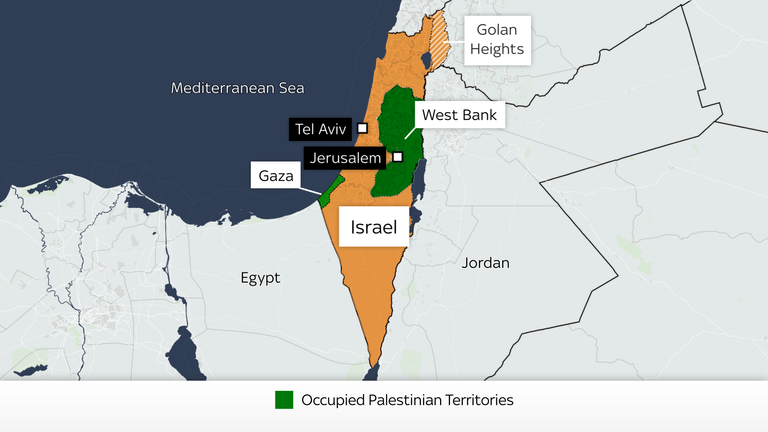
Source: SKY NEWS
Disclaimer: Copyright infringement not intended.
Context
Hamas's October 7, 2023 attack in Israel and the latter's continuing war on Gaza have brought the Palestine question back to the fore of West Asia.
Details
Two-state solution
- Divide historical Palestine, the land between the Jordan River on the east and the Mediterranean Sea in the west, into an Arab state and a Jewish state.
- Israel, a Jewish state, was created in Palestine in 1948. But a Palestine state is not yet a reality. Palestinian territories have been under Israeli occupation since 1967.
- So, a two-state solution today means the creation of a legitimate, sovereign Palestine state, which enjoys the full rights like any other nation state under the UN Charter.
Origins of the two states solution
- During 1930s when the British ruled over Palestine in 1936, the British government appointed a commission headed by Lord William Robert Peel (known as the Peel Commission) to investigate the causes of Arab-Jewish clashes in Palestine.
Commission Recommendation
- In 1937 the commission proposed a partition of Palestine into a Jewish and an Arab state. At that time, Jews accounted for some 28% of Palestine's population.
- According to the Peel Commission proposal, the West Bank, Gaza and Negev desert would make up the Arab state, while much of Palestine's coast and the fertile Galilee region would be part of the Jewish state.
- Arabs rejected the proposal.
UN Special Commission on Palestine (UNSCOP) partition plan
- On 15 May 1947, the General Assembly established UNSCOP, the Commission put forward another partition plan.
Proposal:
- It proposed that Palestine be divided into three territories - a Jewish state, an Arab state and an international territory (Jerusalem). Jews, who made up roughly 32% of Palestine's population, were to have 56% of the Palestine land as per the UNSCOP plan.
- The partition plan was adopted in the UN General Assembly (Resolution 181).
Rejection and Acceptance and the establishment of Israel:
- Arabs rejected the plan (India voted against it), while the Zionist leadership of Israeli settlers in Palestine accepted it.
- And on May 14, 1948. Zionists unilaterally declared the state of Israel. This triggered the first Arab-Israeli war. And by the time an armistice agreement was achieved in 1949, Israel had captured some 22% more territories than what the UN had proposed.
International legitimacy
Territorial Changes and the 1967 Six-Day War
In the Six-Day War of 1967, Israel captured several territories:
- West Bank and East Jerusalem from Jordan
- Gaza Strip and Sinai Peninsula from Egypt
- Golan Heights from Syria
While Israel returned the Sinai Peninsula to Egypt after the 1978 Camp David Accords, it continues to control the other territories.
Emergence of Palestinian Nationalism and the PLO
- 1960s: Palestinian nationalism strengthened under the leadership of the Palestine Liberation Organization (PLO).
- The PLO initially sought the "liberation" of all of Palestine but later shifted to recognizing a two-state solution based on the 1967 borders.
Camp David Accords (1978)
- Followed the 1973 Yom Kippur War, where Egypt and Syria launched a surprise attack on Israel.
- Israel and Egypt agreed to the Framework for Peace in the Middle East, which included:
- The establishment of an autonomous self-governing Palestinian authority in the West Bank and Gaza.
- Implementation of UN Resolution 242, calling for Israel to withdraw from territories occupied in 1967.
Oslo Accords (1993 and 1995)
- Built upon the principles of the Camp David Accords.
- Formalized the two-state solution concept.
- Led to the creation of the Palestinian National Authority (PNA), a self-governing body in the West Bank and Gaza.
- The PLO was recognized internationally as the representative of the Palestinian people.
Challenges to Peace and the Oslo Process
- The promise of Oslo was the creation of a sovereign Palestinian state which would live next to the Israeli state in peace. However, this promise has never been materialised.

Hurdles to achieving the two-state solution
Setbacks to the Oslo Process
Assassination of Yitzhak Rabin (November 1995)
- Yitzhak Rabin, the Israeli Prime Minister who signed the Oslo Accords, was assassinated by a Jewish extremist.
- Yitzhak Rabin's Labour Party was defeated in subsequent elections.
- The right-wing Likud Party, led by Benjamin Netanyahu, came to power.
Rise of Hamas
- Hamas, an Islamist militant group, opposed the Oslo Accords.
- Hamas claimed the PLO made significant concessions to Israel.
- Their opposition further derailed the peace process.
Diplomatic Efforts and Failure to Achieve the Two-State Solution
- Multiple diplomatic attempts were made to revive the two-state plan post-Oslo.
- None of these efforts successfully progressed towards achieving the goal.
Structural Factors Hindering the Two-State Solution
- Boundary Issues
- Israel lacks clearly demarcated borders and is seen as an expansionist state.
- Captured more territories in 1948 than promised by the UN.
- Expanded further in 1967 by taking control of historical Palestine.
- Since the 1970s, Israel has been building illegal Jewish settlements in Palestinian territories.
- Palestinians demand their future state be based on the 1967 borders, but Israel is not willing to commit.
- Status of Settlers
- Approximately 700,000 Jewish settlers live in the West Bank and East Jerusalem.
- Withdrawal to the 1967 borders would require relocating settlers.
- Settlers form a powerful political class in Israel, and no Prime Minister can pull them back without political repercussions.
- Status of Jerusalem
- Palestinians want East Jerusalem, hosting Al Aqsa Mosque, as the capital of their future state.
- Israel claims the whole of Jerusalem, hosting the Western Wall, as its "eternal capital."
- Right of Refugees to Return
- Around 700,000 Palestinians were displaced in 1948 when Israel was declared.
- International law grants them the right to return to their homes.
- Israel refuses to allow the return of Palestinian refugees.
Current Context and Leadership Stance
- Israel's right-wing leadership shows no willingness to make concessions.
- Israel prefers to maintain the status quo of occupation.
- Palestinians seek to break this status quo and establish a sovereign state.
Sources:
Hindu
|
PRACTICE QUESTION
Q. Despite the good relation that exists between India and Israel, consider the significant contribution that India made to the cause of Palestine. 200 words
|












